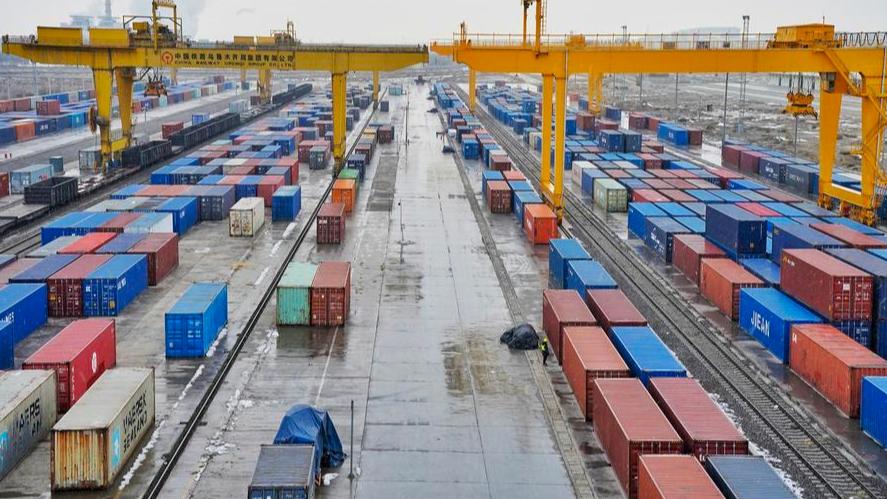
According to China State Railway Group Co., Ltd., by the end of February 2024, the railway service connects 120 Chinese cities with 219 cities across 25 European countries.
The China-Europe Express Rail is also less vulnerable to extreme weather or geopolitical tensions, thus better ensuring the unimpeded flow of international industrial and supply chains.
BEIJING, April 7 (Xinhua) A freight train loaded with containers of goods was departing from China's northern city of Shijiazhuang to the European city of Belgrade, capital of Serbia, in late March.
The train marks the launch of a new route of the China-Europe Railway Express, also the first direct rail line connecting the Beijing-Tianjin-Hebei region with Serbia.
The China-Europe Express Rail transport service has witnessed tremendous expansion since its launch in 2011 and has provided transport and logistics support for Belt and Road cooperation over the years. What has contributed to its evident growth?
REMARKABLE PROGRESS
The China-Europe Express Rail served as a safe and reliable rail line linking Asia and Europe, transporting over 50,000 types of goods, including automobiles, spare parts, clothing, cereals, wine, coffee beans, and timber.
According to China State Railway Group Co., Ltd., by the end of February 2024, the railway service connects 120 Chinese cities with 219 cities across 25 European countries, making it one of the main transport arteries between China and Europe.
The service has expanded steadily in the first two months of this year, with the number of trains reaching 2,928 in January and February, a year-on-year increase of 9 percent.
It also transported approximately 317,000 twenty-foot equivalent units (TEUs) of goods during the first two months of this year, up 10 percent from last year.
SAFE SOLUTION
During the COVID-19 pandemic, the China-Europe Railway Express has proven itself to be a more secure and stable way of cargo transportation as it was less affected compared with other transportation solutions like ships and planes.
Businesses have preferred to choose the railway to transport large quantities of goods and cross-border e-commerce parcels.
Metrans, a major logistics company in Europe, launched its first China-Europe train service in 2017. It now has 20 container terminals across Europe.
"We see the significant importance of cargo going from China by rail, that is why we bought the terminal in Malaszewicze, Poland in January 2022, which is very much connected to the Silk Road and we started to boost the connection to China via Malaszewicze," said Martin Koubek, director of the Silk Road and CIS division of Metrans.
The China-Europe Express Rail is also less vulnerable to extreme weather or geopolitical tensions, thus better ensuring the unimpeded flow of international industrial and supply chains.
"The railway to Europe is a viable alternative and we are seeing increased demand for that route," Marco Forgione, director general at the Institute of Export & International Trade told South China Morning Post in an interview.
Michael Aldwell, head of sea logistics at Kuehne & Nagel, told the Financial Times in March that there was "more demand" to move goods from Asia to Europe by rail under current circumstances, adding that "high-value cargo has always been popular on that route."
INCREASED EFFICIENCY
In recent years, the China-Europe Express Rail service has continued to be more efficient. Today, it takes only about 10 days for a train to travel from China's northwestern city of Xi'an to Duisburg in Germany, two days less than the time it took in 2023.
Julija Sciglaite, RailGate Europe's chief business development officer, told CNBC in February that the company uses the China-Europe Express Rail to transport its products as the journey time is "significantly better" than the sea route.
"Along the routes of China-Europe Express Rail, customs clearance and inspection have become increasingly convenient, the business environment at entry ports has been continuously improved, and rules and regulations related to cross-border transport have become more standardized," said Chinese Foreign Ministry spokesperson Mao Ning at a press conference on Feb. 29.
The Alataw Pass and Horgos Port, two major railway ports in the Xinjiang Uygur Autonomous Region in northwestern China, have optimized the procedures and expanded port capacity to promote transport efficiency along the route.
In 2023, the stopover time of China-Europe freight trains at these ports was reduced to 6 or 8 hours, said Yan Huapeng, an official at the Alataw Pass.
The China-Europe Express Rail service is also developing beyond rail, with the introduction of integrated sea-rail transport routes.
A shipment of electric water heaters was delivered from Thailand to Germany about a month ago through multiple transport solutions, passing through Laos, Vietnam, and China.
The Belt and Road Initiative (BRI), of which the China-Europe Express Rail is a flagship project, is a blueprint that every nation needs in an age of "uncertainty and disruption," said an article published in January in American magazine Foreign Policy, adding that the BRI represents what all countries should do in their own national interest.




 A single purchase
A single purchase









